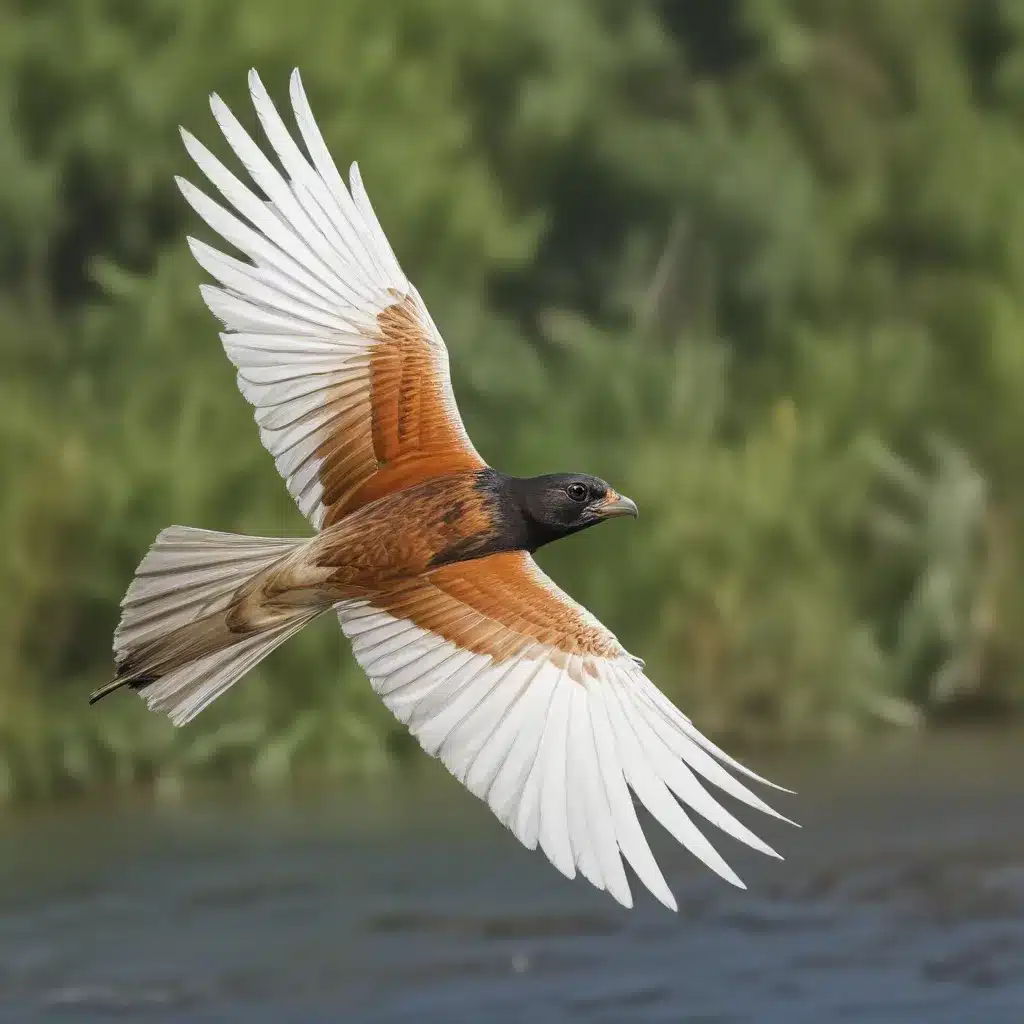
Avian Behaviors and Adaptations
Birds are truly remarkable creatures, with a diverse array of unique behaviors and physical adaptations that allow them to thrive in the sky. As experienced avian caretakers, we have a deep appreciation for the intricate flight mechanics and instinctual flight behaviors that define these feathered flyers.
Flight Mechanics
The ability of birds to effortlessly take to the air is a marvel of evolutionary engineering. Their lightweight, streamlined bodies and powerful wing structures enable them to defy gravity and soar with grace. The shape and construction of a bird’s wings are finely tuned for maximum aerodynamic efficiency. The primary and secondary feathers, arranged in an overlapping pattern, create a smooth, curved surface that generates lift as the wings beat up and down. This intricate wing design, coupled with the strong muscles that power the wing motion, allows birds to generate the thrust needed for takeoff, level flight, and complex aerial maneuvers.
Instinctual Flight Behaviors
Beyond the mechanics of flight, birds possess an innate repertoire of flight-related behaviors that are essential for their survival and well-being. Migratory patterns, for instance, are deeply ingrained in many species, guiding them on seasonal journeys across vast distances in search of favorable breeding grounds or food sources. The graceful aerial displays and courtship flights of birds are not only visually captivating but also serve crucial reproductive functions, helping individuals attract mates and establish territories.
Habitat Requirements for Natural Flight
Providing birds with the appropriate environmental conditions and resources is crucial for supporting their natural flight behaviors. By understanding the specific habitat requirements of different avian species, we can create enriching enclosures and outdoor spaces that cater to their unique needs.
Environmental Factors
The airspace and terrain of a bird’s habitat play a significant role in its ability to express natural flight behaviors. Birds require ample open areas, both horizontally and vertically, to maneuver and soar without obstruction. The presence of diverse vegetation, such as trees, shrubs, and tall grasses, can offer birds the necessary cover, perching spots, and nesting sites to feel secure and thrive.
Enrichment Considerations
Incorporating elements that stimulate a bird’s natural behaviors is essential for its overall well-being. Providing a variety of perching and roosting structures, both at ground level and at elevated positions, allows birds to engage in their instinctual resting and social behaviors. Encouraging foraging and hunting behaviors through the inclusion of suitable food sources and enrichment items, such as hidden treats or moving toys, can further enhance the bird’s physical and mental stimulation.
Conservation and Rehabilitation
As avian caretakers, we have a responsibility to not only support the well-being of our captive birds but also to contribute to the conservation and rehabilitation of wild populations. Understanding the threats faced by birds in their natural habitats and implementing effective rehabilitation practices are crucial for ensuring the long-term survival of these remarkable creatures.
Threats to Wild Populations
Habitat loss and fragmentation, driven by human activities like urbanization, deforestation, and agricultural expansion, pose significant threats to many bird species. Additionally, human-wildlife conflicts, such as collisions with buildings or power lines, can have devastating impacts on wild bird populations. Addressing these challenges through habitat preservation, wildlife-friendly infrastructure, and public education is essential for protecting the future of our feathered friends.
Rehabilitation and Release Practices
In the event of injuries or displacement, the rehabilitation and reintroduction of birds into their natural habitats is a critical endeavor. Assessing a bird’s flight capability through careful observation and testing is a crucial first step, ensuring that the individual is capable of safely navigating the challenges of the wild. Reintroduction techniques, such as soft releases or the use of flight-training enclosures, can help ease the transition and increase the chances of a successful return to the bird’s natural environment.
Aviary Design and Management
Designing and managing aviary spaces that cater to a bird’s natural flight behaviors requires a deep understanding of their specific needs and the principles of enrichment. By considering factors like enclosure size, airflow, and social dynamics, we can create environments that support the overall well-being of our feathered charges.
Structural Considerations
The size and height of an aviary play a vital role in enabling birds to express their natural flight behaviors. Larger enclosures, with ample vertical space, allow birds to take full advantage of their wing span and engage in more complex aerial maneuvers. Careful attention to airflow and ventilation is also essential, ensuring that the aviary environment remains comfortable and conducive to the birds’ well-being.
Behavioral Husbandry
Stimulating a bird’s natural behaviors, such as foraging, hunting, and social interactions, is a crucial aspect of aviary management. Providing a diverse array of enrichment items, from perches and nesting materials to rotating food sources, can encourage these instinctual behaviors and prevent boredom or stress. Additionally, understanding the social dynamics of different avian species and thoughtfully grouping birds can foster a harmonious and enriching community within the aviary.
As experienced avian caretakers, we have the privilege and responsibility of ensuring that our feathered friends have the opportunity to thrive and express their natural flight behaviors. By leveraging our knowledge of avian biology, habitat requirements, and conservation practices, we can create environments that not only support the well-being of our captive birds but also contribute to the preservation of these remarkable creatures in the wild. Visit Mika Birds Farm to learn more about our commitment to avian welfare and how you can contribute to the cause.


